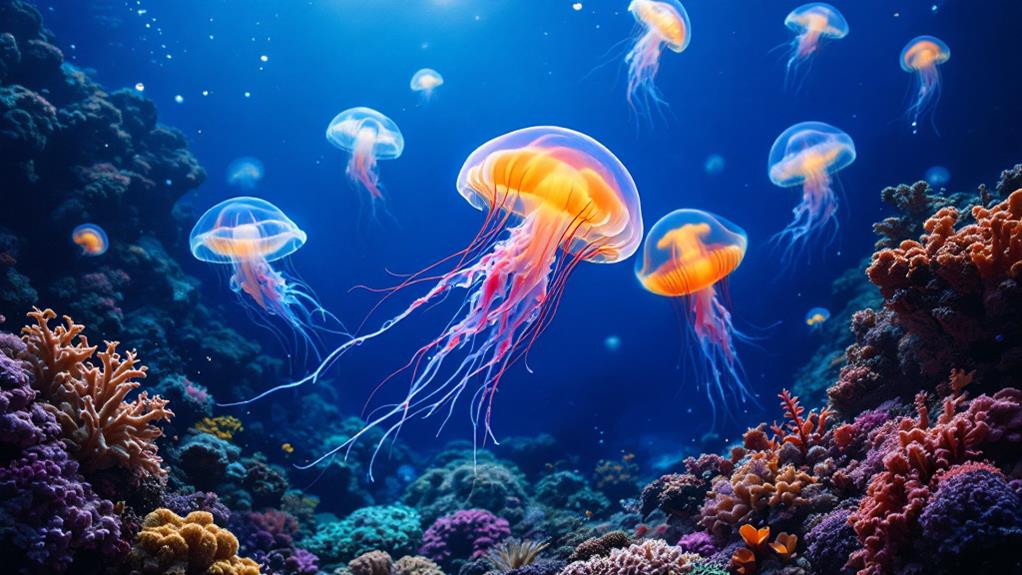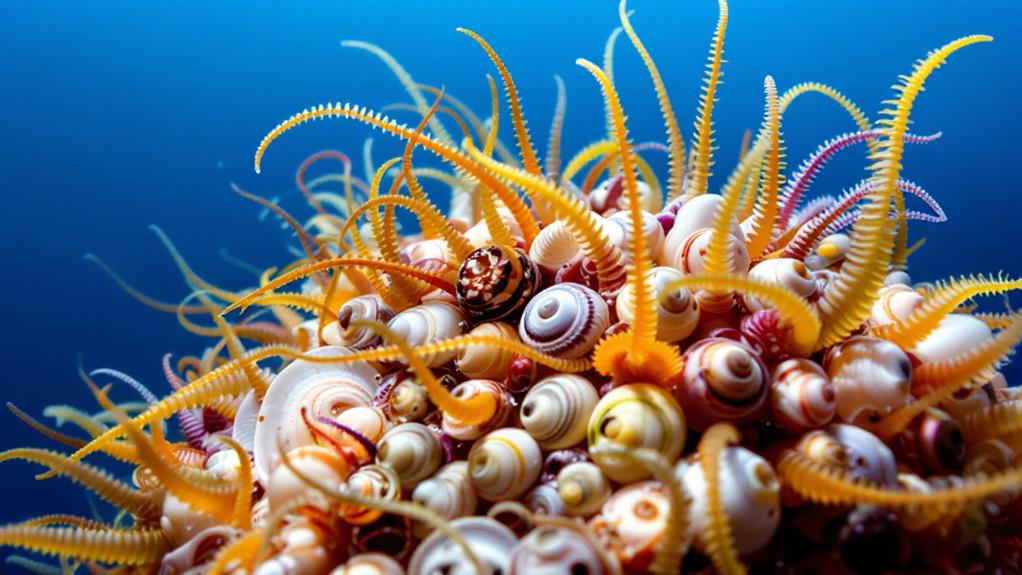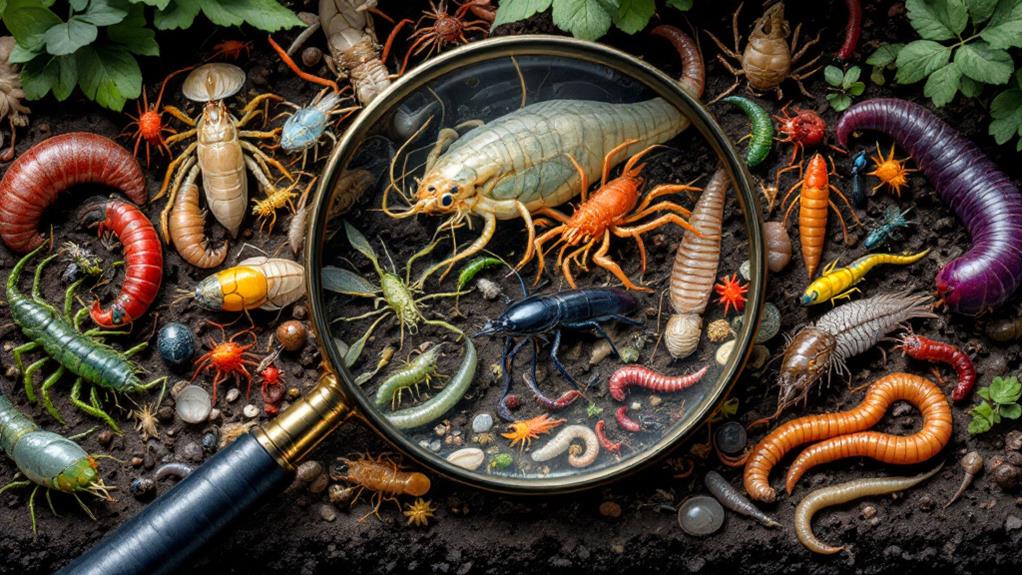Invertebrates are diverse creatures classified into several major groups. You'll encounter Protozoa, single-celled organisms, and Porifera, the sponges. Cnidaria includes jellyfish and corals, while Platyhelminthes and Nematoda cover flatworms and roundworms. Mollusks, like snails and octopuses, have soft bodies and often shells. Annelids are segmented worms, such as earthworms. Arthropods, the largest group, include insects, spiders, and crustaceans. Each category has unique characteristics and roles in ecosystems. From simple structures to complex body plans, invertebrates showcase nature's incredible variety. Exploring further will reveal fascinating details about these remarkable creatures.
Protozoa: Single-Celled Marvels

Under the microscope, protozoa reveal a hidden world of single-celled wonders. These tiny organisms, invisible to the naked eye, are classified as eukaryotes, meaning they possess a membrane-bound nucleus. Despite their simplicity, protozoa exhibit remarkable diversity in form and function.
You'll find protozoa divided into four main groups based on their locomotion methods. Sarcodines, like amoebae, move using pseudopodia—temporary extensions of their cytoplasm. Flagellates propel themselves with whip-like structures called flagella. Ciliates, such as paramecia, are covered in hair-like cilia that beat rhythmically for movement. Sporozoans, the only non-motile group, are parasitic and rely on host organisms for transport.
Protozoa play essential roles in aquatic ecosystems as primary consumers and decomposers. They feed on bacteria, algae, and organic debris, helping to recycle nutrients and maintain ecological balance. Some species form symbiotic relationships with other organisms, like the cellulose-digesting protozoa in termite guts.
While most protozoa are harmless, a few species can cause diseases in humans and animals. Plasmodium, for example, is responsible for malaria, while Giardia causes intestinal infections.
Studying protozoa has led to significant scientific breakthroughs. Their simple structure makes them ideal model organisms for cellular research. Scientists have used protozoa to investigate fundamental biological processes, including cell division, gene expression, and organelle function.
As you explore the world of protozoa, you'll discover that these microscopic organisms are far more complex and influential than their size suggests. They're a reflection of the incredible diversity and adaptability of life on Earth.
Porifera: The Sponge Kingdom
From the microscopic world of protozoa, we now plunge into the diverse domain of Porifera, commonly known as sponges. These aquatic invertebrates are among the simplest multicellular organisms on Earth, with a history dating back over 600 million years.
You'll find sponges in various shapes, sizes, and colors, from tiny encrusting forms to massive barrel-shaped structures. They're primarily marine animals, though a few freshwater species exist. Sponges lack true tissues and organs, instead relying on a unique body plan composed of specialized cells.
The sponge's body is built around a system of water channels and chambers. They feed by filtering water through tiny pores called ostia, trapping food particles with specialized collar cells called choanocytes. This efficient feeding method allows them to process vast amounts of water daily.
Sponges are classified into three main classes: Calcarea (calcareous sponges), Hexactinellida (glass sponges), and Demospongiae (the largest and most diverse group). Each class has distinct skeletal structures, composed of either calcium carbonate, silica, or protein fibers called spongin.
Despite their simple appearance, sponges play significant roles in marine ecosystems. They provide habitat for various organisms, contribute to nutrient cycling, and even produce compounds with potential medical applications.
When studying Porifera, you'll encounter fascinating adaptations. Some species can regenerate from tiny fragments, while others form symbiotic relationships with algae or bacteria. Their ability to survive in diverse aquatic environments showcases the remarkable flexibility of these ancient invertebrates.
Cnidaria: Jellyfish and Corals

As we drift from the world of sponges, we encounter the enchanting phylum Cnidaria. This diverse group includes jellyfish, sea anemones, hydras, and corals. Cnidarians are characterized by their radial symmetry and specialized stinging cells called cnidocytes.
You'll find cnidarians in two main body forms: polyps and medusae. Polyps are sessile, attaching themselves to surfaces, while medusae are free-swimming. Some species, like jellyfish, alternate between these forms during their life cycle.
Cnidarians have a simple body plan with two cell layers: the outer ectoderm and inner endoderm. Between these layers is a gelatinous substance called mesoglea. They possess a single opening that serves as both mouth and anus, surrounded by tentacles used for capturing prey and defense.
The phylum is divided into four main classes: Hydrozoa, Scyphozoa, Cubozoa, and Anthozoa. Hydrozoa includes hydras and some jellyfish-like creatures. Scyphozoa contains the true jellyfish, while Cubozoa comprises the box jellyfish. Anthozoa includes sea anemones and corals.
Cnidarians play significant roles in marine ecosystems. Coral reefs, formed by colonial anthozoans, provide habitat for countless species. Jellyfish are important components of the ocean's food web, serving as both predators and prey.
When studying cnidarians, you'll notice their remarkable ability to regenerate damaged tissues. Some species can even reverse their aging process, making them subjects of intense scientific interest. As you explore this phylum, you'll discover a world of fascinating adaptations and ecological significance.
Platyhelminthes and Nematoda
Two phyla that might make you squirm are Platyhelminthes and Nematoda. These groups include flatworms and roundworms, respectively, and they're found in diverse habitats worldwide.
Platyhelminthes, or flatworms, are soft-bodied, unsegmented worms with a flattened shape. You'll find them in aquatic and moist terrestrial environments. They lack a body cavity and circulatory system, relying on diffusion for gas exchange and nutrient distribution. Flatworms have a simple nervous system with a brain-like structure and eyespots. Some are free-living, while others are parasitic. Notable examples include planarians, flukes, and tapeworms.
Nematoda, or roundworms, have cylindrical bodies and are found in soil, freshwater, marine environments, and as parasites in plants and animals. They possess a pseudocoelom, a body cavity that isn't fully lined with mesoderm. Nematodes have a complete digestive system with a mouth and anus, unlike flatworms. Their body is covered by a tough, flexible cuticle that they shed as they grow.
Both phyla exhibit bilateral symmetry and have three germ layers (ectoderm, mesoderm, and endoderm). However, they differ in body structure and complexity. Platyhelminthes are acoelomate, while Nematoda are pseudocoelomate. Nematodes have a more advanced nervous system and sensory organs compared to flatworms.
These phyla include numerous species of medical and agricultural importance. Many are parasites that can cause diseases in humans, animals, and plants. Understanding their biology and life cycles is vital for developing control strategies and treatments for parasitic infections.
Mollusks: Shells and Tentacles

Moving from the world of worms, we encounter a diverse group of invertebrates known as mollusks. These soft-bodied animals are characterized by their unique body plan, which typically includes a muscular foot, a visceral mass, and a mantle that often secretes a protective shell.
You'll find mollusks in various habitats, from oceans to freshwater and even on land. They're divided into several classes, including gastropods (snails and slugs), bivalves (clams and oysters), and cephalopods (octopuses and squids). Each class has distinct features, but they all share common ancestral traits.
The shell is a vital feature for many mollusks, providing protection and support. It's composed of calcium carbonate and grows with the animal. However, some mollusks, like slugs and octopuses, have reduced or absent shells.
Tentacles are another significant characteristic, especially in cephalopods. These appendages serve various functions, including sensing the environment, capturing prey, and locomotion. In octopuses, you'll observe eight arms lined with suckers, while squids have eight arms and two longer tentacles.
Mollusks have a unique feeding structure called a radula, a ribbon-like organ covered in tiny teeth used for scraping or cutting food. This adaptation allows them to consume a wide variety of food sources.
Reproduction in mollusks varies widely. Some are hermaphroditic, while others have separate sexes. Many species undergo complex life cycles, including larval stages that differ greatly from adults.
Understanding mollusk classification helps you appreciate their diversity and ecological importance. These animals play vital roles in aquatic and terrestrial ecosystems, serving as both predators and prey in food webs.
Annelids: Segmented Worms
Annelids, a fascinating group of segmented worms, represent another important phylum in the invertebrate world. You'll find these creatures in various environments, from marine and freshwater habitats to terrestrial ecosystems. Their most distinctive feature is their segmented body structure, which allows for greater flexibility and specialization of body parts.
You can identify annelids by their cylindrical bodies divided into ring-like segments. Each segment contains a set of muscles, nerves, and often specialized organs. This segmentation enables annelids to move efficiently through soil or water using a process called peristalsis. You'll notice that many species have bristles called setae, which aid in locomotion and anchoring.
Three main classes of annelids exist: Polychaeta (mostly marine worms), Oligochaeta (earthworms and their relatives), and Hirudinea (leeches). Polychaetes often have distinct head regions and parapodia for movement. Oligochaetes, like earthworms, play essential roles in soil health. Leeches are known for their ability to suck blood and their medicinal uses.
Annelids exhibit various feeding strategies. Some are filter feeders, others are predators, and many are detritivores. You'll find that they reproduce both sexually and asexually, with some species capable of regenerating lost body parts.
These worms contribute greatly to ecosystem functions. Earthworms, for instance, improve soil structure and nutrient cycling. Marine annelids are important food sources for many aquatic animals. Some species serve as indicators of environmental health, making them valuable in ecological studies and conservation efforts.
Arthropods: Joint-Legged Invertebrates

Comprising the largest and most diverse phylum in the animal kingdom, arthropods are joint-legged invertebrates you'll encounter in virtually every ecosystem on Earth. These remarkable creatures are characterized by their segmented bodies, exoskeletons, and jointed appendages. They've evolved into an astonishing array of forms, from tiny mites to giant crabs.
Arthropods are divided into four main subphyla: Chelicerata, Crustacea, Myriapoda, and Hexapoda. Chelicerates include spiders, scorpions, and horseshoe crabs, distinguished by their lack of antennae and specialized mouthparts called chelicerae. Crustaceans, such as crabs, shrimp, and barnacles, are primarily aquatic and breathe through gills. Myriapods, like centipedes and millipedes, have numerous body segments with many legs. Hexapods, including insects, are the most diverse group, with six legs and often wings.
You'll find arthropods have adapted to numerous ecological niches. They've developed various feeding strategies, from filter-feeding barnacles to predatory mantises. Many play essential roles in ecosystems as pollinators, decomposers, or prey for larger animals. Some species, like honeybees and silkworms, are economically important to humans.
Arthropods' success is largely due to their exoskeleton, which provides protection and support. However, this rigid structure requires molting for growth. They've also evolved sophisticated sensory organs, including compound eyes and sensitive antennae, allowing them to navigate their environments effectively. Understanding arthropod diversity and adaptations is key to appreciating their significance in the natural world.

Erzsebet Frey (Eli Frey) is an ecologist and online entrepreneur with a Master of Science in Ecology from the University of Belgrade. Originally from Serbia, she has lived in Sri Lanka since 2017. Eli has worked internationally in countries like Oman, Brazil, Germany, and Sri Lanka. In 2018, she expanded into SEO and blogging, completing courses from UC Davis and Edinburgh. Eli has founded multiple websites focused on biology, ecology, environmental science, sustainable and simple living, and outdoor activities. She enjoys creating nature and simple living videos on YouTube and participates in speleology, diving, and hiking.

